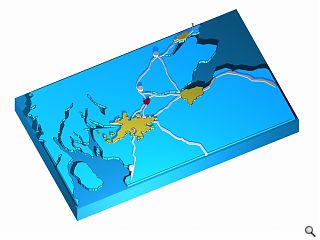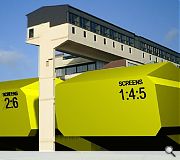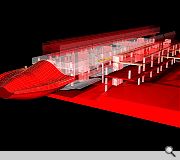Gordon Murray outlines post-Carbuncle future for Cumbernauld
February 4 2013
On the eve of judging for the Carbuncle awards the Cumbernauld Environmental Society have staged a conference looking at how best Cumbernauld town centre might be regenerated – and head off the possible award of another Plook. Amongst the delegates was architect and Professor Gordon Murray who delivered a summary of the research and design work which he and his students have been involved with for the problematic New Town. Below is a transcription of his talk:I was born in Airdrie and I’ve lived in Airdrie all my life - I thought if I said that early on I’d have an affinity with one or two people here! As a schoolboy in Airdrie there were two buildings which had an impact on me and encouraged me to become an architect, Cumbernauld town centre and the South Lanarkshire Council buildings, I’ve been in love with the place ever since.
This is the front cover from Architectural Design in 1963, fifty years ago, it’s a reminder of what is Cumbernauld’s history, it’s also a reminder that Cumbernauld was built as a town centre. It wasn’t built as a retail centre. It wasn’t built as a shopping centre; it was built as a town centre. It is the only collective memory of the town that exists. Everything else that other towns have like a library, police station or hospital were all encapsulated into this building under the original design.
It was such an important building for its time that architects came from all over the world to look at it. Kenzo Tange when he was building the Tokyo Olympic buildings came over, Lewis Mumford the historian came over because, of all Scotland’s town centres, it was seen as a radical, transformative experience.
As both an architect and an academic I’ve never come across anyone who has never said it was a fantastic place. Yes there is criticism of it, yes there have been changes over the years but everybody thought it was a fundamentally important place to be.
Cumbernauld was designed in the form of a medieval walled town and part of the problem has been the idea has never been followed through. It’s always been frozen at a point in time. The potential it had for developing as a town centre on the basis of the diagram created in the original concept was I think quite powerful and quite strong.
There is a fantastic archive in South Carbrain where you can build up an archaeology of the town using its base information and it allows you to understand the logic that’s behind the town centre and examine where the potential and difficulties might lie. Part of the problem has been the accretion over the years of various bits and pieces to the town centre so a lot of the legibility of the original diagram has been lost as a consequence.
In terms of the history of Cumbernauld you can’t get away from that underlying archaeology in some form, the collective memory that everyone has of Cumbernauld is embedded in that diagram. In Linlithgow, Bo’ness, or Airdrie there is a collective memory too. People say ‘oh do you remember 30 years ago when that shop wasn’t there, that street wasn’t there.’ A collective memory builds up and that’s the only thing we’ve really got to hang onto.
One of the things we started doing was try to unpick the archaeology of the town centre and how it was originally constructed and what the elements in that were to see if there were any relevant and real or whether there was something there that was so buried and so obscure that there was no reason for it to remain.
We found that the structure was massively overdesigned so that you could put in a cinema, or a library requiring extra loading and the building would deal with that. It was built for its time so that route through the building east/west and north/south were clear but a lot of that has become obscured over time.
When we looked at the original town centre there is also what I call the second town centre to the north of the dual carriageway and the Antonine Centre. The Antonine Centre became the focal point for the premier shops in Cumbernauld as shops in the original town centre moved north, leaving it sitting with nothing in it. This led us to investigate the night and leisure economy and how that might fit in. If we were going to do anything with the town centre it wouldn’t be about retail, it would be about leisure - creating a place that people want to remain in.
Rather than working or living in Cumbernauld and then going into Glasgow for some form of leisure activity, people in Airdrie might actually want to come to Cumbernauld. In fact when I was 15 I wanted to come to come to the bowling alley that was at the top of the town centre, principally because I could get in at 15 and get a pint.
By opening it up we could take it back closer to what it was originally and introduce complimentary uses to other parts of the town centre. Changes in legislation in how you deal with smoke and escape in a town centre changed over time and we felt we could open up the development to a greater degree with large open spaces and bridges across, relocating the library and introducing a cinema to stimulate this as the heart of the town centre.
The problem has gone beyond the original 1950-60 town centre to the wider context that we’ve got today and how we can actually knit the buildings back together. I think it’s more about place making and public realm than it is about encouraging people to come back into the spaces between the buildings as much as it is about the buildings themselves.
|
|
4 Comments
#1 Posted by Lauren on 4 Feb 2013 at 11:46 AM
Well put Gordon. I think cumbernauld has true potential. Some of the housing is fantastic, under disrepear exists some of amazing examples of 20th C modernism. Having been grossly out of fashion for decades we hav lost the ability to appreciate the qualities of this place. Watching Gregory's girl makes you view this place through different eyes. The moderness of the housing is something to behold. The sort of thing we are not capapble (seemingly) to deliver now but lust at in other countries. Cumbernauld is a conservation area of the future. It is in a great location and must be preserved now for the future.
#2 Posted by Eric on 5 Feb 2013 at 08:06 AM
Good god Eburgh can fit into Glasgow inner circle subway.
#3 Posted by wonky on 5 Feb 2013 at 14:42 PM
Got to disagree with Lauren. Cumbernauld should never have been built in the first place- did Modernists really believe we would have an endless supply of oil/gas/petrol to sustain these car dependent isolated towns on the edges of the suburban sprawl? Its ib a terrible location as well, unlike East Kilbride. EK has prospered because of its proximity to Glasgow, particularly the affluent well populated south-side. Cumbernauld is just too remote, too far out of the urban cluster to really work, especially without better transport links. It should never have been built, like Irvine, Glenrothes, Livingston and EK, as it has weakened the power, influence and tax generating funds of the city- what exactly where the corporation thinking? Barcelona, Hamburg, Lisbon, Copenhagen, Helsinkii, Stockholm, Vienna, Lyon and even Birmingham have all retained their power, inflluence and wealth generation by preserving their geographic integrity and population size. Pandora's box has been well and truly opened so there is no going back...the Corporations crimes were not isolated only to the destruction of great architectural heritage and rich urban districts but also to the weakening of the city's status as a European power player...reversals of that process has occurred to a certain extent but I can't see how we can return to a high density city with a sustainable increasing population, especially in a country where people still dream of an out of town car centred, back-front-door house life. Why has a nation like Finland, very much like our own, still have over 50% of people living in apartments? Live in eco-friendly urban ways close to their work so they can walk or cycle to where they need to go.Can't we increase our train networks/their quality at the expense of roads/cars? Would it be so bad for us to live in culturally rich densely populated urban community with varied indie shops, bars etc than car convenient soulless suburban malls buying homogenised brands?
The question is how do we educate people away from the old model and how do we recalllibrate their expectations to something more long-term and sustainable?
Personally I don't see any long term future for Cumbernauld or Irvine or places like them- I think they may only be a few generations removed from what is already happening in places like Greenock or an Airdrie.
The question is how do we educate people away from the old model and how do we recalllibrate their expectations to something more long-term and sustainable?
Personally I don't see any long term future for Cumbernauld or Irvine or places like them- I think they may only be a few generations removed from what is already happening in places like Greenock or an Airdrie.
#4 Posted by Mal on 18 Feb 2013 at 22:20 PM
Totally disagree with Wonky regarding the location of EK being better than Cumbernauld! Cumbernauld is in a prime location and very easy to get from both public and private transport unlike EK. It is much quicker and easier to get in to Glasgow city centre from Cumbernauld than EK plus Cumbernauld is on the main route north! The problem with the place is North Lanarkshire council that direct all the funds to places like Motherwell and Wishaw. NLC will be the death of Cumbernauld if the needs don't destroy it first!
Post your comments
Read previous: Foster + Partners reveal out of this world Moon base plan
Back to February 2013
Like us on Facebook
Become a fan and share
News Archive
Search News
Features & Reports
For more information from the industry visit our Features & Reports section.





